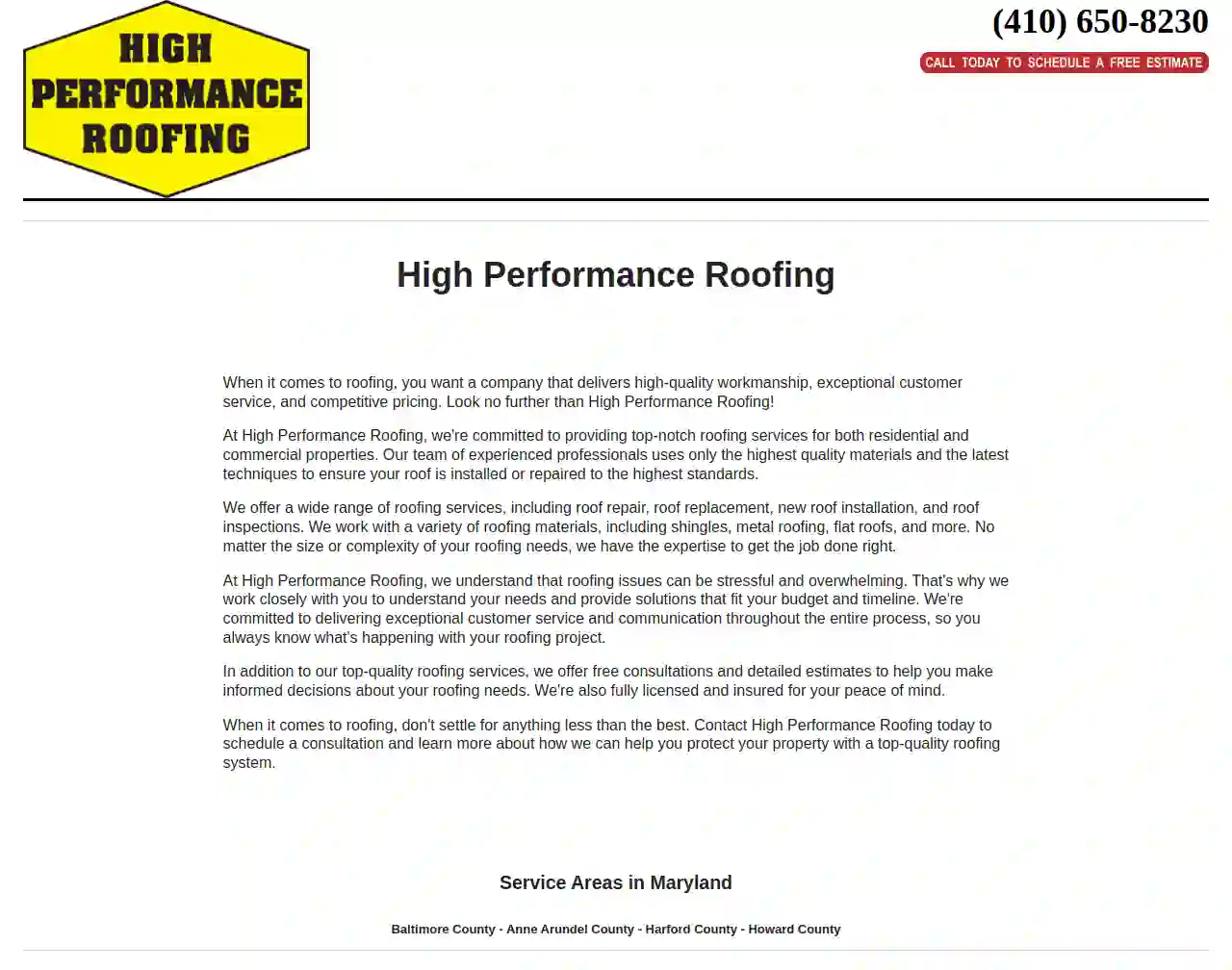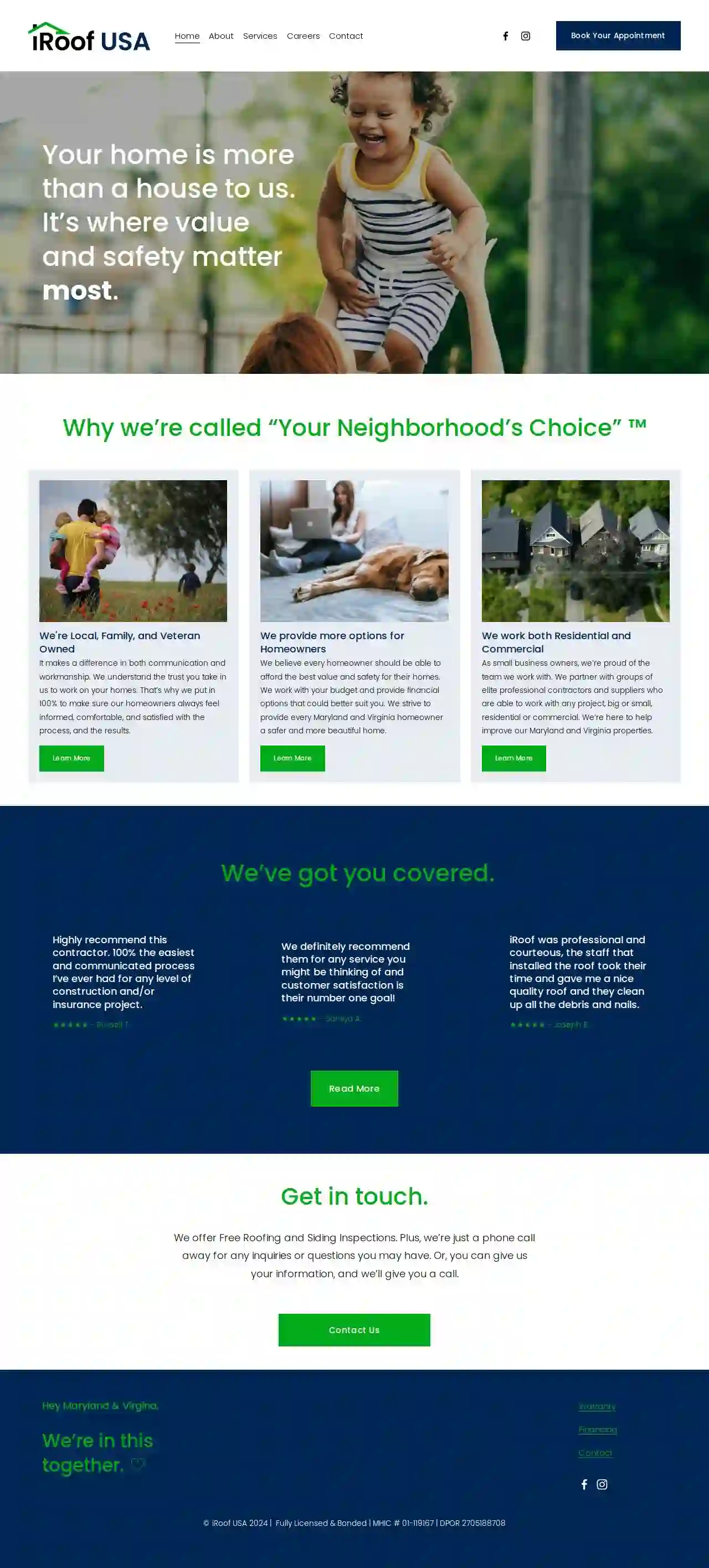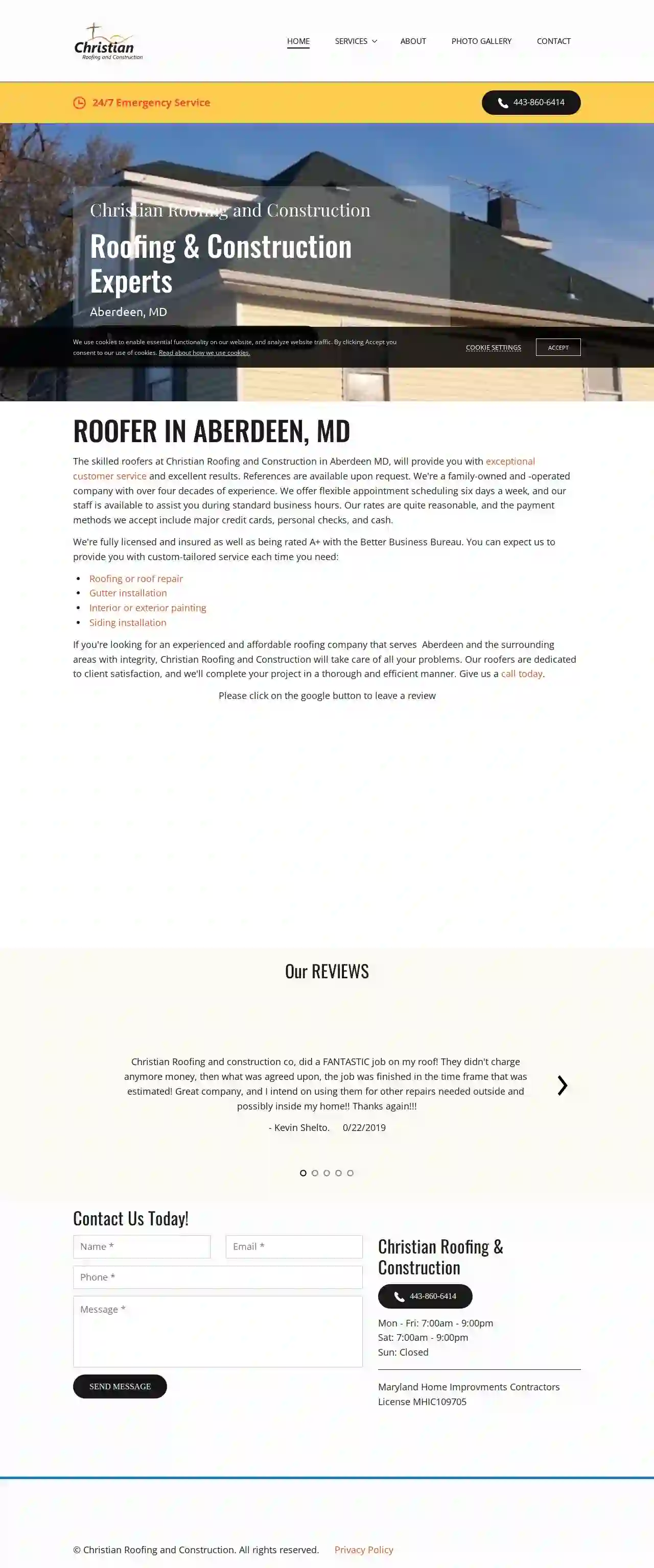Roofing Companies Langley Park
Top 10 Roofers in Langley Park
Receive up to 3 Roofing Companies quotes for your project today! Compare profiles, reviews, accreditations, portfolio, etc... and choose the best offer.

Roof Replacement Pros - Montgomery Village
Montgomery Village, 20886, USThe Roof Replacement Pros of Montgomery Village are your trusted local roofing experts. We offer a wide range of roofing services for both residential and commercial properties, including roof inspections, replacements, repairs, and more. We are committed to providing our clients with the highest quality workmanship and customer service at competitive prices. Whether you need a new roof or just a few repairs, our experienced roofers can help. We use only the best materials and techniques to ensure that your roof is properly installed and will last for years to come. We understand that your roof is one of the most important investments you can make in your home or business. That's why we take the time to carefully assess your needs and provide you with a customized solution that meets your budget and your expectations. Contact us today for a free estimate!
- Services
- Why Us?
- Gallery
Get Quote
High Performance Roofing
Baltimore, USHigh Performance Roofing is your go-to company for top-notch roofing services in Maryland. We're dedicated to delivering high-quality workmanship, exceptional customer service, and competitive pricing for both residential and commercial properties. Our team of experienced professionals utilizes the highest quality materials and the latest techniques to ensure your roof is installed or repaired to the highest standards. We offer a comprehensive range of roofing services, including roof repair, roof replacement, new roof installation, and roof inspections. Whether you need shingles, metal roofing, flat roofs, or any other type of roofing material, we have the expertise to handle your project. We understand that roofing issues can be stressful, so we work closely with you to understand your needs and provide solutions that fit your budget and timeline. Our commitment to exceptional customer service and clear communication ensures you're always informed throughout the entire process. In addition to our quality services, we offer free consultations and detailed estimates to help you make informed decisions about your roofing needs. For your peace of mind, we are fully licensed and insured. Don't settle for anything less than the best when it comes to your roof. Contact High Performance Roofing today to schedule a consultation and learn how we can protect your property with a top-quality roofing system.
- Services
- Why Us?
- Gallery
Get Quote
Piney Orchard Roofing
541 reviewsOdenton, MD, 21113, USAt Piney Orchard Roofing, we specialize in providing high-quality new roof installations and complete roof replacements for homeowners in Odenton, MD, and the surrounding areas. Our commitment is to make the entire process as affordable, simple, and painless as possible. From personalized service to advanced technology for precise estimations, we strive to exceed your expectations. We are so confident in our estimation process that we offer price-matching guarantees on any detailed proposals from our competitors. Our roofing specialists utilize aerial imagery and 3D modeling to provide detailed analyses and accurate estimates. We understand that a new roof is a significant investment, and we work closely with you to ensure you receive the best possible value for your money. We are a local business dedicated to serving our community with integrity and professionalism. Our team of experienced roofers is committed to delivering exceptional workmanship and customer satisfaction. Contact us today for a free, no-obligation estimate and experience the Piney Orchard Roofing difference.
- Services
- Why Us?
- Accreditations
- Our Team
- Testimonials
- Gallery
Get Quote
Liberty Roofing Center
4.36 reviewsFrederick, USLiberty Roofing Centers has been dedicated to providing better choices for our customers since the beginning: better roofing and exterior building materials, better service, better advice and know-how. We believe in treating every customer like a friend and neighbor, earning their business by going the extra mile and building strong, lasting relationships. We know you have a choice of roofing solutions and exterior building product suppliers, which is why we developed the Liberty Bill of Rights. It hangs on every wall in every branch, and our people deliver on it every day. When it comes time to choose a supplier that will stand up for your rights, remember: You have a right to Liberty.
- Services
- Why Us?
- Gallery
Get Quote
Fredericksburg Roofers
55 reviewsFredericksburg, VA, 123 Main St, 22401, USFredericksburg Roofers is a locally owned and operated roofing company that takes great pride in our work. We never take shortcuts – we make sure we do a good job every time. Our excellent customer service, high-quality materials, and professional work make us stand out. We offer a variety of roofing services, including residential and commercial roofing, roof inspections, asphalt shingle roofing, and more. We pride ourselves on providing the best customer services and quality of work that Fredericksburg has to offer in the world of Roofing. We can help with any Roofing project you may encounter in and around Fredericksburg, Virginia.
- Services
- Why Us?
- Our Team
- Gallery
Get Quote
BC Remodeling
Hagerstown, MD, 21740, USBC Remodeling is a reliable roofing and siding contractor operating in Hagerstown, MD. We offer a wide range of services, including roofing, siding, gutters, home improvement, kitchen and bathroom renovation, flooring, drywall, and interior and exterior painting. Our team of skilled professionals is dedicated to ensuring customer satisfaction. With a strong presence in Hagerstown, MD, we are committed to providing exceptional services to our clients.
- Services
- Why Us?
- Testimonials
- Gallery
Get Quote
A & B Home Improvement
4.419 reviews111 Riverside Dr, Essex, 21221, USA & B Home Improvement is a home improvement contractor in Baltimore County, serving Essex, Baltimore, and Harford County, MD. We've been in business since 1938, with three generations of experience. Our team is committed to providing the highest quality craftsmanship on all projects, using only the best materials and latest technology. We offer a wide range of services, including roofing, siding, remodeling, and home improvement. Contact us today to learn more or schedule a consultation.
- Services
- Why Us?
- Gallery
Get Quote
Harriss Roofing Inc.
4.824 reviews1203 Dorsey Rd, Glen Burnie, 21061, USHarriss Roofing Inc is a family-owned roofing company in Glen Burnie, MD, offering comprehensive, customer-driven services under one roof. With over 35 years of experience, we specialize in residential and commercial roofing, siding, gutters, skylights, and windows. Our team of highly-qualified roofing contractors is dedicated to maintaining customer satisfaction and providing high-quality materials and attention to detail. We are accredited with the Better Business Bureau and offer free estimates.
- Services
- Why Us?
- Accreditations
- Gallery
Get Quote
iRoof USA
530 reviewsBaltimore, USAt iRoof USA, we strive to deliver strategic, efficient and high quality services. Our team focuses on your restoration needs, and diligently works with you and your budget to successfully restore the value and safety of your home. Your home is more than a house to us. It’s where value and safety matter most. We're Local, Family, and Veteran Owned. It makes a difference in both communication and workmanship. We understand the trust you take in us to work on your homes. That’s why we put in 100% to make sure our homeowners always feel informed, comfortable, and satisfied with the process, and the results. We believe every homeowner should be able to afford the best value and safety for their homes. We work with your budget and provide financial options that could better suit you. We strive to provide every Maryland and Virginia homeowner a safer and more beautiful home.
- Services
- Why Us?
- Testimonials
- Gallery
Get Quote
Christian Roofing and Construction llc.
4.425 reviewsBaltimore, USChristian Roofing and Construction is a family-owned and -operated roofing company serving Aberdeen, MD and the surrounding areas for over 40 years. We are a third-generation company that values personal service, honesty, and integrity. We use high-quality name-brand materials like GAF, CertainTeed, and Owens-Corning. We offer a wide ranges of services including roof repairs, roof replacements, shingle and flat roofing, soffit and fascia repair/replacement, gutters and downspouts, painting, masonry repairs, waterproofing, siding replacement, and aluminum and vinyl siding refinishing. We are licensed and insured, have plenty of great references, and ensure our customers are always happy with our work. We offer a satisfaction guarantee on our work and up to a 50-year warranty on materials. Christian Roofing and Construction is BBB Accredited and has an A+ rating with the Better Business Bureau.
- Services
- Why Us?
- Accreditations
- Testimonials
Get Quote
Over 17,196+ Roofing Companies registered
Our roofing experts operate in Langley Park & surroundings!
Roofyng.com has curated and vetted the Best Roofing Businesses near Langley Park. Find a trustworthy pro today.
Frequently Asked Questions About Roofing Companies
- Clear the Area: Remove any vehicles, outdoor furniture, or other items from around your house to provide the roofing crew with easy access.
- Protect Landscaping: Cover plants, shrubs, and other landscaping elements near the house with tarps or plastic sheeting to protect them from falling debris.
- Clear the Attic: Remove or cover items stored in your attic, as dust and debris might fall through during the removal of the old roof.
- Notify Neighbors: It's courteous to inform your neighbors about the upcoming roof replacement project, especially if it's likely to be noisy or disruptive.
- Discuss Logistics with the Contractor: Coordinate with the roofing contractor regarding access to your property, parking arrangements, and any special instructions or concerns you have.
- Experience: Companies with a solid track record and years of experience in the industry.
- Licensing and Insurance: Verify they are properly licensed to operate in your area and carry adequate insurance to protect you from liability.
- Certifications: Look for certifications from reputable organizations, demonstrating expertise in specific roofing materials or techniques.
- Positive Reviews: Check online reviews and testimonials from previous customers.
- Professionalism: Choose a company that communicates clearly, provides detailed estimates, and has a courteous and responsive team.
- Safety First: Avoid going onto the roof during a storm, as it's dangerous.
- Document the Damage: Take photos and videos of the damage for insurance purposes.
- Contact Your Insurance Company: Report the damage to your insurance company as soon as possible to initiate a claim.
- Temporary Repairs: If safe, address any immediate leaks using buckets or tarps to minimize further damage.
- Contact a Roofing Contractor: After the storm, have a qualified roofing contractor inspect the roof and provide a repair estimate.
- Experience: 'How long have you been in business, and what experience do you have with similar projects?'
- Licensing and insurance: 'Are you licensed and insured, and can I see proof of coverage?'
- Warranties: 'What warranties do you offer on your work and the materials used?'
- References: 'Can you provide references from past clients?'
- Project Timeline: 'What is the estimated timeline for completing the project?'
- Payment Terms: 'What are your payment terms, and do you require a deposit?'
- Communication: 'How will you keep me updated on the project's progress?'
- Cleanup: 'What steps will you take to protect my property during the project and ensure proper cleanup afterward?'
How do I prepare for a roof replacement?
How do I find a good roofing company?
What should I do if my roof is damaged in a storm?
What questions should I ask a roofing contractor?
How do I prepare for a roof replacement?
- Clear the Area: Remove any vehicles, outdoor furniture, or other items from around your house to provide the roofing crew with easy access.
- Protect Landscaping: Cover plants, shrubs, and other landscaping elements near the house with tarps or plastic sheeting to protect them from falling debris.
- Clear the Attic: Remove or cover items stored in your attic, as dust and debris might fall through during the removal of the old roof.
- Notify Neighbors: It's courteous to inform your neighbors about the upcoming roof replacement project, especially if it's likely to be noisy or disruptive.
- Discuss Logistics with the Contractor: Coordinate with the roofing contractor regarding access to your property, parking arrangements, and any special instructions or concerns you have.
How do I find a good roofing company?
- Experience: Companies with a solid track record and years of experience in the industry.
- Licensing and Insurance: Verify they are properly licensed to operate in your area and carry adequate insurance to protect you from liability.
- Certifications: Look for certifications from reputable organizations, demonstrating expertise in specific roofing materials or techniques.
- Positive Reviews: Check online reviews and testimonials from previous customers.
- Professionalism: Choose a company that communicates clearly, provides detailed estimates, and has a courteous and responsive team.
What should I do if my roof is damaged in a storm?
- Safety First: Avoid going onto the roof during a storm, as it's dangerous.
- Document the Damage: Take photos and videos of the damage for insurance purposes.
- Contact Your Insurance Company: Report the damage to your insurance company as soon as possible to initiate a claim.
- Temporary Repairs: If safe, address any immediate leaks using buckets or tarps to minimize further damage.
- Contact a Roofing Contractor: After the storm, have a qualified roofing contractor inspect the roof and provide a repair estimate.
What questions should I ask a roofing contractor?
- Experience: 'How long have you been in business, and what experience do you have with similar projects?'
- Licensing and insurance: 'Are you licensed and insured, and can I see proof of coverage?'
- Warranties: 'What warranties do you offer on your work and the materials used?'
- References: 'Can you provide references from past clients?'
- Project Timeline: 'What is the estimated timeline for completing the project?'
- Payment Terms: 'What are your payment terms, and do you require a deposit?'
- Communication: 'How will you keep me updated on the project's progress?'
- Cleanup: 'What steps will you take to protect my property during the project and ensure proper cleanup afterward?'